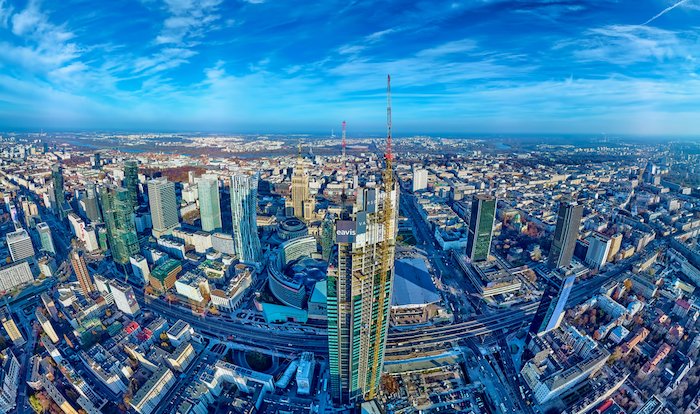This cool capital is the largest city in Poland. Located east of the centre, in the heartland of the Masovian Plain, it’s divided in two by the Vistula River. Beloved for its cutting-edge architecture, burgeoning art scene and fascinating history, millions visit the city every year. Planning a trip to the Polish capital city? From forests to mermaids, here are a few interesting facts about Warsaw that might surprise you.
Interesting facts about Warsaw
1. Warsaw is greener than you think it is
Over 14% of Warsaw is woodlands. The Kampinos National Park, which sits just outside of the city, is one of Poland’s most famous forested areas. It covers around 38,544 hectares and is home to more than 1,400 species of vascular plants.
It’s brimming with parks, botanical gardens and nature reserves too. The city is home to 88 parks in total, including the impressive Lazienki Park, which sprawls across 188 acres. Other highlights include the Wilanów Park, next to the enchanting Palace of King Jan III Sobieski, and the Pole Mokotowskie Park, which is often compared with Central Park in New York.
2. Warsaw is nicknamed the “Phoenix City”
Warsaw is known as the “Phoenix City” due to the number of times it has been destroyed and risen again. The city itself dates back to fortified settlements founded in the 6th century, though the town didn’t really grow until the 14th century. It suffered colossal damage during the Swedish occupation of 1655 to 1656. Then, in 1794 the Russian army massacred the population of the right bank suburb of Praga. During World War II, Warsaw was razed to the ground by bombing raids. After liberation, the People’s Republic of Poland rebuilt the city once more.
Warsaw’s Old Town is the oldest part of the city and dates back to the 13th century. Nazi troops destroyed more than 85% of the district during the Warsaw Uprising of August 1944, but a five-year reconstruction campaign led by its citizens resulted in the meticulous restoration of the Old Town, complete with its churches, palaces and marketplace. In 1980 UNESCO designated it a World Heritage site.
3. Warsaw is one of the most congested cities in Europe
Warsaw is one of the most congested cities in Europe, with citizens spending an average of 106 hours sitting in traffic every year.
Poland is one of the countries with the highest number of registered motor vehicles in Central and Eastern Europe, with a value twice as big as that registered in the Czech Republic. This, combined with poor road infrastructure means that journey times in Warsaw during congested periods are 42% longer when compared to the non-congested periods. Travel times are 89% higher during the mornings and 86% in the evening peak hours.
4. Warsaw is home to the tallest building in the EU
The Varso Tower became the tallest building in the European Union in February 2021. It measures 310 metres (1,017 ft) high and boasts 53 storeys. Before that, The Palace of Culture and Science was the tallest building in Poland. The Soviet-Russian architect Lev Rudnevin designed the building in the ‘Seven Sisters’ style in 1955. It boasted the tallest clock tower in the world until the installation of a clock on the NTT Docomo Yoyogi Building in Tokyo. Today it houses various cultural institutions such as cinemas, theatres, libraries and the Polish Academy of Sciences.
5. Warsaw is home to the narrowest house in the world
Keret House is the narrowest building in the world. The two-storey building is squeezed between a gap between two disparate other buildings. At its slimmest, it measures just 92 cm (36 inches) and at its widest, it is still only 152 cm (59 inches).
The Polish architect Jakub Szczesny presented the artistic concept at the WolaArt Festival in 2009 and building finished in 2012. It boasts a functional living space and is now a temporary home for travelling writers.
6. Mermaids are everywhere in Warsaw
The Mermaid of Warsaw, or the Syrenka, is a symbol of Warsaw. It first appeared on Warsaw’s coat of arms in 1390, followed by a seal in 1459. Experts claim the coat of arms was likely inspired by the 2nd-century book, Physiologus, though there are a few legends surrounding the mermaid. One tells that a mermaid decided to stay after pausing on a riverbank near the Old Town. Local fishermen planned to trap her, but they heard her singing and fell in love. A rich merchant managed to imprison her but when the fishermen heard her cries, they rescued her. Ever since she’s vowed to protect its residents with a sword and shield. Another story tells that she’s related to her equally famous sister, the Little Mermaid in Copenhagen.
7. Some of the world’s most prolific people were born or lived in Warsaw
Marie Curie, who achieved international recognition for her research on radioactivity and was the first female recipient of the Nobel Prize, was born in Warsaw.
The composer Fryderyk Chopin spent his childhood and early youth in Warsaw too. When he died in Paris, his sister managed to sneak his heart out of France so that he could be buried in his native country, as he wished.
The post 7 Interesting Facts About Warsaw appeared first on Big 7 Travel.
